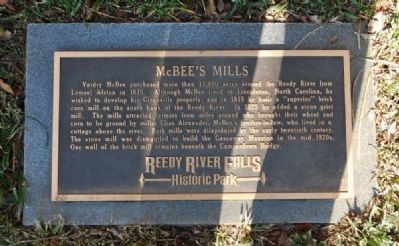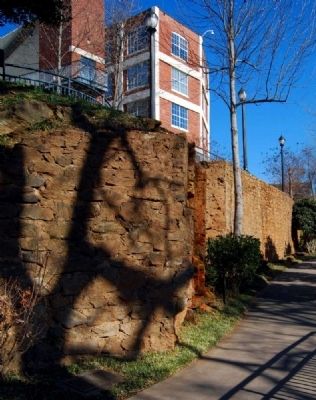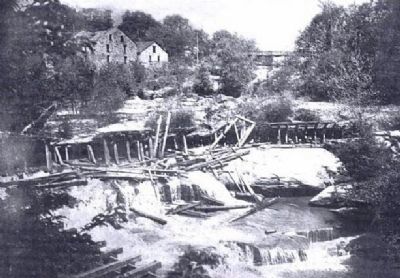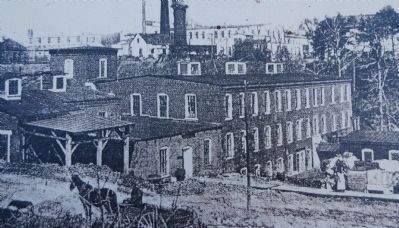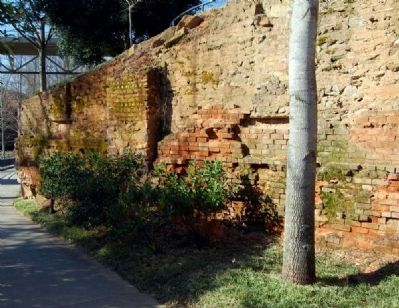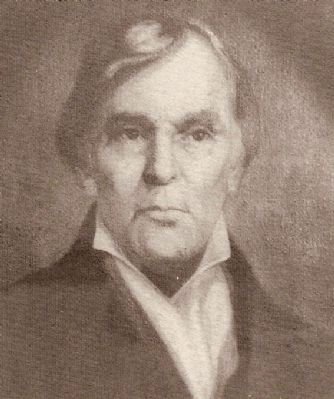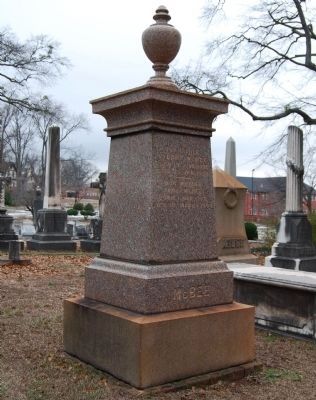Greenville in Greenville County, South Carolina — The American South (South Atlantic)
McBee's Mills
Reedy River Falls Historic Park
Topics. This historical marker is listed in these topic lists: Industry & Commerce • Settlements & Settlers • Waterways & Vessels. A significant historical year for this entry is 1815.
Location. 34° 50.683′ N, 82° 24.083′ W. Marker is in Greenville, South Carolina, in Greenville County. Marker can be reached from South Main Street. Marker is located in Historic Falls Park. Upon entering the park, take the stairs down to the bridge level. Take the elevator down one floor and follow the path back toward Camperdown Bridge. Touch for map. Marker is in this post office area: Greenville SC 29601, United States of America. Touch for directions.
Other nearby markers. At least 10 other markers are within walking distance of this marker. Reedy River Falls (here, next to this marker); Hunting Grounds to Mill Town (here, next to this marker); Liberty Bridge (here, next to this marker); Paul Ellis, III Overlook (here, next to this marker); History of Falls Park (within shouting distance of this marker); The Reedy River (within shouting distance of this marker); Harriet Smith Wyche (within shouting distance of this marker); Tate Plaza (within shouting distance of this marker); Falls Place (within shouting distance of this marker); Vardry Dixon Ramseur, III (within shouting distance of this marker). Touch for a list and map of all markers in Greenville.
More about this marker. This marker is one of a series of markers in the Historic Falls Park covering bits of Greenville's history.
Also see . . . Reedy River. The Reedy River is a tributary of the Saluda River, about 65 mi long, in northwestern South Carolina in the United States. (Submitted on March 1, 2010, by Brian Scott of Anderson, South Carolina.)
Additional commentary.
1. About Vardry McBee
Vardry McBee was perhaps the most pivotal figure in the history of our city and Greenville County as a whole. thanks to his business acumen and impressive foresight for how the community could grow and prosper.
A product of the Carolina frontier, McBee was born in 1775 on the eve of the American Revolution, a conflict that would prove formative in his early years. Both his father and older brother fought with the Patriots, at King's Mountain and the Battle of Cowpens. McBee himself never fought for American independence, but instead used his considerable fortune to improve the lives of his fellow citizens, appropriating his land and fortunes to public projects.
McBee opened the first textile mill on the Reedy River, but he saw value in a diversified economy. In his private business life, that meant he owned two flour mills, a cotton factory, and wool and paper mills. Publicly, even as he approached his 80s, it led him to champion the construction of a railroad line that connected Columbia and Greenville. In 1853, this line became the first rail to serve the community, and it would eventually become a turning point in the economy of the town. (Source: G: The Magazine of Greenville, Jan/Feb 09, pg 66.)
— Submitted March 1, 2010, by Brian Scott of Anderson, South Carolina.
2. More About Vardry McBee
The early history of Greenville had no more interesting or significant figure
than Vardry McBee, who in fact measured up to all that was intended when he was called "a model man of enterprise for the South and the country." After he had passed the high tide of life's activities, and twelve years before his death, which occurred at Greenville, January 23, 1864, in his eighty-ninth year, an interesting sketch of his career was published in De Bow's Review of September, 1852. It is a historic document, and the salient features of the article are reproduced here.
He was born in Spartanburg District of South Carolina, June 19, 1775, and the Revolutionary battles of Cowpens and Cedar Springs were fought within a few miles of his father's home, and he was old enough to see and be impressed by many events of that struggle. His parents came from Virginia and were among the earliest settlers of Upper Carolina. His father, though of the religious faith of the Friends, commanded a company for several years in the Revolution. After the war, being heavily in debt, he had to mortgage his property, including the famous Limestone Springs, and finally lost his fortune altogether.
Vardry had to leave school at the age of twelve and for the next six years was a farm laborer on the Limestone Farm, where his father remained, though the title had passed to other owners. In 1794 he began an apprenticeship at the saddler's trade at Lincolnton, North Carolina. During
1800, after completing his apprenticeship he was employed for a brief time as a clerk in Charleston, but in the fall of the same year accompanied his parents on their removal to Kentucky. The following year he established a saddlery in middle Tennessee, but soon returned to North Carolina and engaged in business as a merchant at Lincolnton, where he prospered and laid the foundation of a large fortune. In 1805 he retired from mercantile lines, and devoted his time to agriculture and other increasing interests. Agriculture was his favorite subject, and he reclaimed a large amount of badly worn soil and again and again carried off premiums for maximum productiveness of his fields. Fully three-quarters of a century ago he was practicing the modern doctrine of restoring soil fertility by the use of clovers and other leguminous crops. In 1812 he was elected clerk of the County Court at Lincolnton and held that office twenty-one years.
While Mr. McBee did not become a resident of Greenville until 1836, he had bought in 1815 a large domain of several thousand acres in and around the village. At that time he had only a modest fortune, as fortunes were then estimated, and it was against the protests of friends and relatives that he bargained with Col. L.J. Allston for these lands at a price of $27,500. While a few acres of the property at the present time would appraise at more
than that figure, it required unusual sagacity and foresight to approve the wisdom of the purchase 100 years ago. Greenville then contained only a few houses and about a hundred inhabitants, but Mr. McBee saw it on one of the great western thoroughfares, recognized its climatic and topographic advantages, and particularly the immense water power which would make a great center of industry.
Soon after making the purchase he gave his personal impetus to industrial progress, building a flour mill in the village in 1817, another one of stone in 1829. Seven miles below the city on Reedy River, he developed from time to time a nucleus of manufactures, including grist mill, paper mill, cotton factory, and woolen mill —- all pioneer industries that have special interest to the modern industrial City of Greenville.
After removing to Greenville in 1836 he devoted himself to the improvement of his lands and agriculture. He would have been an exceptional farmer even in the twentieth century, since he abhorred the idea of "mining" the wealth of the soil, and always practiced the sound policy of steadily making his land better.
He was extremely liberal toward every local improvement. He gave lands for tht male and female academy at Greenville and sites for the various churches. In the history of early railroad construction through this part of the South his name and service are indelibly fixed. He succeeded General Hayne as president of the project of the Louisville & Cincinnati Railroad. When the project of the Greenville & Columbia Railroad was about to fail, he subscribed $50,000, thus making the largest individual subscription ever made to a railroad in the United States up to that time. He also liberally supported the enterprises of the Seaboard & Rpanoke and the Charleston, Louisville & Cincinnati Railroads.
To quote the direct words of the article from which the above is taken: "It may with great truth be said of Mr. McBee, that very few men who have made their fortunes have appropriated so much of them to public purposes * * * Mr. McBee never engaged in an enterprise that did not succeed. As a saddler he commenced his fortune, had a high reputation for his work, and laid the foundation of that immense estate which he now owns. As a merchant, with numerous branches of his mercantile business at Lincolnton, Spartanburg, Greenville and elsewhere, during some fifty years, he has been everywhere successful. As an extensive manufacturer of cotton and woolen cloths and paper he has been equally successful.
"In morality and all the proprieties of life, Mr. McBee has no superior. His habits are all strictly temperate and methodical. He is a man of great industry and activity. He retires to bed early and arises before daylight every morning. Having been crippled when a young man, by being thrown from a horse, he is not able to walk any distance. He consequently lives mostly in his saddle during the day. Although now nearly seventy-seven years old, he rides fifty miles a day, and feels no inconvenience from it. He enjoys fine health, though his constitution has always been delicate. There is the same uniformity and regularity in his dress that there is in his habits and manners. In person, Mr. McBee is small, with a mild and pleasing expression of face. In his manners he is kind and gentle, with the simplicity of a child. Seldom is he excited by anything, but there is in him a sleeping passion which is sometimes aroused."
In 1804 he married Miss Jane Alexander, daughter of Col. Elias Alexander of Rutherford County, North Carolina. The unfretted currents of their lives ran side by side for nearly sixty years, and she died less than two months after her beloved husband on March 13, 1864. A granddaughter of this historic couple is Mrs. C.M. Landrum of Greenville, from whom this data was secured. (Source: History of South Carolina, Volume 4 by Yates Snowden, pgs 261-262.)
— Submitted March 1, 2010, by Brian Scott of Anderson, South Carolina.
Credits. This page was last revised on November 16, 2020. It was originally submitted on March 1, 2010, by Brian Scott of Anderson, South Carolina. This page has been viewed 1,730 times since then and 56 times this year. Photos: 1, 2, 3, 4. submitted on March 1, 2010, by Brian Scott of Anderson, South Carolina. 5. submitted on December 20, 2008, by Brian Scott of Anderson, South Carolina. 6. submitted on March 1, 2010, by Brian Scott of Anderson, South Carolina. 7. submitted on September 20, 2009, by Brian Scott of Anderson, South Carolina. 8. submitted on January 11, 2009, by Brian Scott of Anderson, South Carolina.
